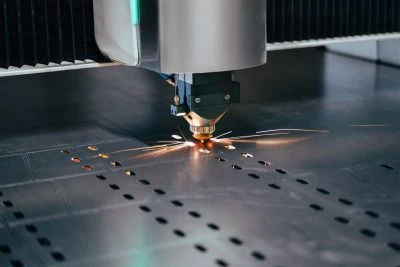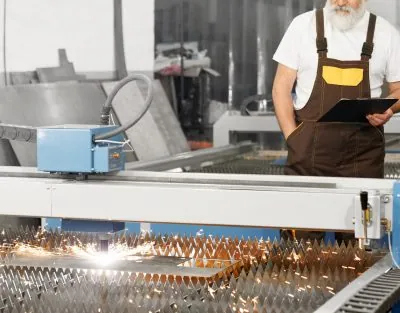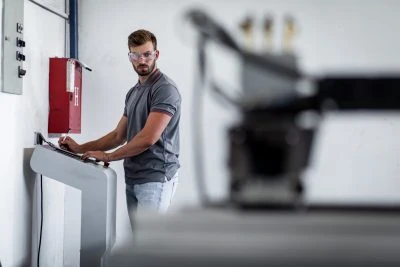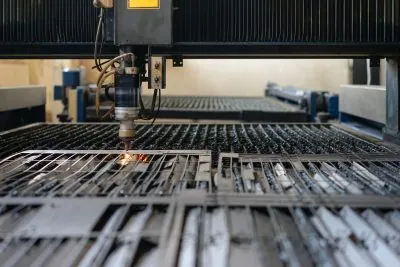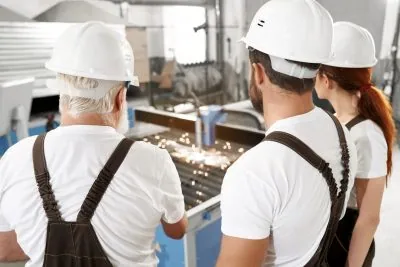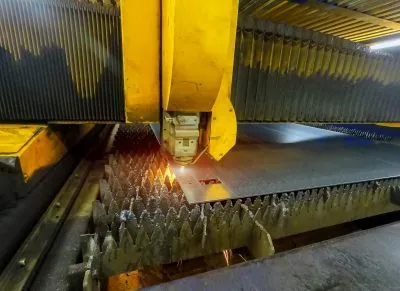Laser cutting technology has grown by leaps and bounds since laser energy was first harnessed to cut metal parts more than 60 years ago. Today, various manufacturing operations rely on the extreme precision and cutting speed that modern laser cutting machines can provide. With these capabilities, sheet metal laser cutting services can address a wide range of manufacturing operations.
Businesses in industrial manufacturing and other similar sectors can rely on modern laser cutting techniques for sheet metals of all varieties. The best laser cutting machines can handle different cutting operations to craft custom metal parts in virtually any size and shape. This includes even thin sheets to thicker materials.
The sheer number and range of cutting techniques to craft metal parts can revolutionize virtually any manufacturing process. However, the process of how sheet metal laser cutting is conducted can seem initially daunting for businesses or industrial manufacturing companies that are used to older or other cutting methods.
An expert laser cutting services provider can guide the way when it comes to sheet metal cutting. Additionally, they can explain the different options for laser cutting techniques and cutting operations required for sheet metal parts. In the meantime, decision-makers can brush up on the fundamentals of metal laser cutting to better understand how laser cutting machines can transform sheet metals into any desired shape, product, or metal part.
Table of Contents
What is Sheet Metal Laser Cutting?
Types of Lasers for Sheet Metal Cutting
Sheet Metal Laser Cutting Processes
Benefits of Sheet Metal Laser Cutting
Discover our Expertise in Sheet Metal Laser Cutting
What is Sheet Metal Laser Cutting?
In the simplest terms, sheet metal laser cutting entails using high precision laser beams to cut sheet metal into specified shapes and designs.
Different types of laser cutting machines are available, from plasma cutters to solid state lasers to crystal lasers. However, the cutting operations are generally the same regardless of the laser cutting machine. The laser cutters’ laser beam vaporizes outlined portions of the metal sheet as specified, leaving behind the desired shape, bend, cut, or other alteration. Virtually any metal sheet can undergo the metal laser cutting process to create the desired metal parts. This includes anything from stainless steel to thing materials like aluminum.
Sheet Metal Laser Cutting and the Laser Cutting Process
Regardless of the material (like mild steel or stainless steel) or the exact type of laser cutting machine, the metal cutting process is somewhat universal.
The first step is to create specific metal cutting instructions via highly specialized CAD software. This software outlines precisely where the laser beams or laser light must be focused in order to create the desired cuts, shapes, and bends required in the manufacturing process of metal parts.
These instructions are then fed to the computer numerical controlled (CNC) laser cutting machine. Then, it conducts the laser cut on individual pieces of sheet metal. The laser beam vaporizes or melts away the material as needed, leaving no excess waste or incorrect laser cuts behind.
The laser cutting process is repeated as many times as needed to address manufacturing projects of up to thousands of metal parts simultaneously. The ensuing high precision, speed, and hands-free machine operation ensures that every sheet metal cutting project is performed seamlessly. This process can transform metal sheets into the desired end-result metal part or product.
Types of Lasers for Sheet Metal Cutting
Purchasing a laser cutting machine to perform sheet metal cutting can be a high initial investment for manufacturing companies. This is especially true for companies that do not have the budget for a laser cutting machine, the facilities, and the expert technicians required for the cutting process.
As such, most manufacturers turn to experts in quality laser cutting services to orchestrate laser cutting sheet metal projects in a short timeframe and at an affordable rate. The best laser cutting services providers have cutting edge and top-quality metal laser cutting machines. Therefore, the cutting methods can be tailored to conduct laser cutting metal projects of all varieties efficiently.
A sample of some of the most popular and commonly used laser cutting machines includes the following.
Fiber Lasers
Fiber lasers were introduced in the 1980s for laser cutting sheet metal projects. Additionally, fiber lasers remain some of the most common laser cutting machines for sheet metal projects of all kinds.
Fiber lasers are considered part of the solid-state laser family, and they use seed lasers to amplify the laser beam with special glass fibers. Fiber lasers are well-known in the laser cutting world for precision and versatility. On the other hand, a fiber laser can cut sheet metals like mild steel or stainless steel of both minimum and maximum thickness, as well as various other materials, including glass, plastics, and even wood.
Fiber lasers also produce some of the most stable and strongest laser beams and require minimal maintenance. However, they are best suited for cutting sheet metals with less than with less than 20 mm thickness.
Crystal Lasers
Crystal lasers generate laser beams from one of two types of crystals – Nd: YAG or Nd: YVO – and may also be referred to as a diode laser. (Alaser diode – or diode laser – is a semiconductor device that undergoes stimulating emission to emit coherent light, and laser diodes are the most common type of laser produced.)
While crystal lasers are a relatively new technology in the laser cutting world, they can produce laser beams with a high cutting power. They can also be used for laser cutting sheet metal as well as other materials, like ceramics. The main drawback to crystal lasers is the cost. Also, they are not as durable as other laser cutting machines, and crystal lasers can be an expensive option for laser cutting sheet metal on a routine basis.
CO2 Lasers
CO2 lasers are another standard option for laser cutting sheet metal. They produce laser beams by running an electric current through a tube filled with a combination of inert gases, specifically nitrogen and helium.
CO2 laser cutting machines are typically efficient and cost-effective and are ideal for laser cutting sheet metal of all varieties – from thin materials to heftier, stainless steel sheets. Although they have less laser cutting power than other types of laser cutting machines (like fiber lasers), they can handle metal sheets and various other materials, like wood, plastics, and even paper.
Sheet Metal Laser Cutting Processes
All of the above laser cutting machines use the power of laser beams to cut metal sheets into metal parts. Therefore, the laser cutting process essentially has two interworking components occurring at once. In one method, the sheet metal material absorbs the focused laser beam, which causes the cut. The other process entails the cutting nozzle, which is concentric to the lasers, providing the process gas that is required for the laser cut.
With this in mind, there are traditionally three distinct sheet metal laser cutting methods.
Laser Beam Fusion Cutting
The laser beam fusion cutting process involves using an inert gas (primarily nitrogen or argon) for the laser cutting process. The low-reaction process gas continuously and routinely vaporizes the specified areas of the sheet metal, removing the molten material. Meanwhile, the inert gas prevents oxidation at the cutting edge without altering the overall laser cutting operation.
Laser beam fusion cutting is best suited for flat, thin sheet metals like aluminum or stainless steel. These specific materials require high precision and limited finishing or post-production alterations.
Laser Beam Sublimation Cutting
Laser beam sublimation cutting evaporates specified areas of sheet metal instead of melting the sheet metal into desired shapes or metal parts. In this laser cutting process, sheet metal or other material is instantly changed from solid to gas through laser beam sublimation, creating perfect edges and laser cuts.
Laser beam sublimation cutting can certainly be used for metal cutting projects. However, it’s also commonly used for non-metal materials that need laser cut, like leather, wood, and textiles.
Laser Beam Flame Cutting
Laser beam flame cutting (also called reactive laser cutting) uses a combustible gas – such as oxygen. It then can thrust out the molten material in a metal sheet. The laser beam flame essentially heats the metal sheet workpiece, creating spontaneous combustion after the metal is melted. The oxygen gas that is used in laser beam flame cutting provides energy for the laser cutting process through oxidation. Therefore, as a result, there can be burns on the cutting surface if the laser cutting operation is not performed correctly.
Laser flame cutting is best for cutting mild steel and other fusible metals or non-metals, such as ceramics. However, this laser cutting technique is best orchestrated by an expert to prevent burns on the metal sheet.
Benefits of Sheet Metal Laser Cutting
While there are other methods available for cutting sheet metal, like CNC milling, waterjet cutting, plasma cutting, or Electrical Discharge Machining, using a laser for cutting sheet metal has a vast range of benefits.
A sample of the potential benefits of using laser cutters for cutting sheet metal includes the following.
Accuracy and high precision
A laser beam provides some of the most precise cutting available, which means that even the smallest cuts, bends, or engravings can be tackled with a laser cutting machine. This process can also be repeated again and again for thousands of units, with every metal part perfectly replicated.
Reduced waste
Since the laser beam in a laser cutter effectively melts or vaporizes the material, there is reduced waste when cutting sheet metal. In addition, because the laser beam is so precise, the amount of metal parts or pieces that can be extracted from a sheet metal workpiece is maximized. As a result, it helps to reduce costs on excess raw materials.
Automated laser cutting
Once the CAD software defines the initial laser cut specifications, all steps of the sheet metal laser cutting process are automated. Including factors such as directing the laser beam to the sheet metal to adding finishes like engravings or bends. As a result, the laser cut process can operate 24/7, with no human involvement required to ensure that the metal laser cutting operations are uniform and perfectly orchestrated.
Cost-effective
When it comes to time, a strong workforce, and maximizing the raw materials or sheet metal, it’s hard to beat the cost-effective nature of a laser cutting machine. A laser cutter may be cost-prohibitive for a manufacturer to purchase and use in-house. However, a laser cutting service provider can save companies across all industries money by cutting sheet metal to specifications and shipping the metal parts back to the company’s home base.
Versatile
A laser cutter can address a wide array of materials, from varying types of sheet metal to wood, plastic, and other commonly used materials in manufacturing processes. Laser cutters are adept at addressing a wide array of manufacturing needs. This is why they are heavily utilized in all types of industries – from manufacturing vehicles to creating the minute metal parts required in electronics and medical equipment.
Environmentally Friendly
A laser beam is a highly effective cutting technique that reduces waste and requires little power or maintenance to operate. As a result, laser cutting is often considered one of the most environmentally friendly laser cutting processes available to manufacturers, compared to traditional cutting methods.
Discover Our Expertise in Sheet Metal Laser Cutting
Laser cutting metal is an intricate process requiring the best laser cutter equipment, facilities, and technicians available to ensure that every laser–cutting metal project is perfectly executed from start to finish.
Since it is cost prohibitive to do in-house, the smartest move for manufacturers who want to take advantage of the skill and precision that modern laser cutters can provide is to partner with an expert resource.
At Steelway Laser Cutting, we have handled laser cutting metal projects of all sizes and varieties and for all kinds of industries. We use the best laser cutters available to perform every project, and our attention to detail is second to none, ensuring that your manufacturing projects and metal parts are perfectly orchestrated, time after time.
An efficient laser cutter can change the game regarding the manufacturing projects you manage every day. Steelway Laser Cutting can provide the best service possible to ensure that your laser cutting projects meet and exceed all expectations.
Reach out to our professional and knowledgeable team to start a discussion about your manufacturing project needs. Learn more about how our laser cutters can provide the precision and accuracy required to allow your business to reach new levels of productivity and quality.
With Steelway Laser Cutting as your resource for laser cutting metal of all varieties, you can ensure that your metal parts and projects are completed to the highest standards available.
Article reviewed and approved by Director of Product Design – Derek McAvoy.

